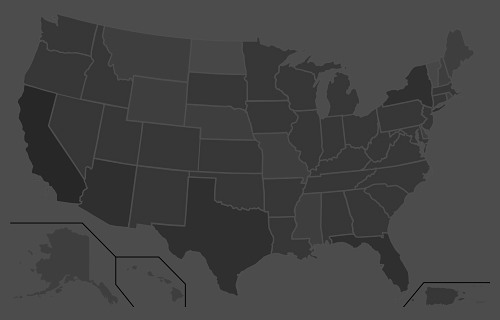“Our added winter moisture and active calling period led to a very long nesting and hatching season, starting in late April and extending into early summer, with chicks hatching as late as early July,” O’Dell said. “From a population standpoint, we are out of a deficit for the first time since 2001-2002. Quail are starting to pop up in places they haven’t been seen in a while.
“If you’ve never had the chance to experience what Arizona quail hunting built its name on, then this would be the year to get out and enjoy it.”
Meanwhile, hunters should note that the season for Mearns’ quail doesn’t begin until Dec. 4. It’s summer rainfall that plays a key role in nesting success and population numbers of this species. After a spotty and relatively weak monsoon across southern Arizona, these birds are likely to be abundant only in pockets that received sufficient precipitation this summer.
A valid Arizona hunting or combination hunt and fish license is required for all hunters 10 and older. Those hunters under 10 must either have a valid hunting or combination hunt and fish license, or be accompanied by an adult who possesses a valid hunting or combination hunt and fish license. Licenses can be purchased online or at license dealers statewide. A youth combination hunt and fish license (ages 10 to 17) is $5.
The general bag limit is 15 quail per day in the aggregate, of which no more than eight may be Mearns’ quail (when the Mearns’ season opens Dec. 4). The general possession limit is 45 quail in the aggregate after opening day, of which no more than 15 Gambel’s, scaled or California quail in the aggregate may be taken in any one day. After the opening of the Mearns’ season, the 45-quail possession limit may include 24 Mearns’ quail, of which no more than eight may be taken in any one day.
More quail-hunting information can be found on the department’s website at https://www.azgfd.com/Hunting/. Another resource for both new and experienced hunters alike is “An Introduction to Hunting Arizona’s Small Game.” Written by Randall D. Babb, the 196-page, full-color book covers where and how to hunt small game birds (like quail), squirrels, rabbits, ducks and geese. It also includes how to prepare and cook your harvest, with illustrations and recipes. The book can be ordered for $16.95 at www.azgfd.gov/publications.
Finally, hunters should check out O’Dell’s techniques for field-dressing quail at https://www.youtube.com/watch?v=3gRwZAcWzzk.
####
Publishers Notes: OUT OF STATE HUNTERS, FISHERMEN & OUTDOOR ENTHUSIASTS; Due to the Covid 19 pandemic, there could be limitations for OUT of STATE hunters, fishermen and other outdoor enthusiasts to include a 14-day quarantine requirement or negative COVID-19 testing alternative. Please check with the State's Department of Natural Resources BEFORE you travel or apply for the 2020 Fall Hunts.
Disclaimer: The views expressed on this site are that of the authors and not necessarily that of TBC Press
Idaho Anglers Expecting Big Steelhead Fishing Opportunities this Spring
Submitted by: TBC Press
Posted on: 02/19/21
The Backcountry Press
The country's premier daily HUNTING, FISHING & OUTDOOR news in the USA and around the globe. Read whats happening in your neck of the woods & beyond.
© 2020 TBC Press - All Rights Reserved Website Design by:
News # 14228
In the Upper Salmon River, the Deadwater ice jam was still in place on Feb. 16, and Salmon Region Fisheries Manager Greg Schoby said he expects it will be early March at the earliest before it breaks up and spring steelhead season began in earnest in his region.
Dupont said that as catch rates pick up, they are likely to remain high into April for most waters, but added that they will vary throughout the spring depending on weather and river conditions.
As most folks know, the weather in Idaho is unpredictable in late winter and early spring. Warm weather, or rainy weather, can turn rivers into muddy torrents and make steelhead fishing difficult, so paying attention to the weather and river flows is critical to success.
Anglers can see a gauge of river flows thanks to the U.S. Geological Survey, which has gauging stations throughout Idaho. By watching the weather and the stream flows, anglers can track in real time what’s happening with the rivers.
Steelhead typically like “Goldilocks” conditions, not too high and not too low and with a little color in the water (think emerald green), but not muddy. Warming water (even just a few degrees) often offers better fishing.
Steelhead fishing also tends to improve when a river recedes after a big pulse of runoff. Good steelhead anglers, or lucky ones, can catch fish in almost any conditions, but using those guidelines will help you improve your chances of catching fish.
To further fine tune your knowledge, anglers can check Fish and Game's harvest reports to see how the fishing is. When it comes to monitoring the harvest reports, be forewarned that when the reports are good, you may still miss the prime fishing because the fish may have passed through that section of the river.
"The key thing I always remind anglers to look at are the catch rates," Dupont said. "When you see catch rates at under 10 hours per fish, we call that good. When it's five hours a fish, that's excellent."
Another option is to check the hatchery returns, which helps you track when fish start arriving at hatcheries, and it can also be an indicator of how many remain in the river nearby.
A phone call to Fish and Game regional offices or local tackle shops can also provide anglers with useful and timely information.
By doing a little homework and watching the weather, you can take your best shot at going fishing when rivers are in good shape and fish are there. Remember those dates because there's a fair-to-good chance it will be similar the next year.
####
Publishers Notes: Our country is still battling COVID-19. To avoid the spread of this virus and continue to enjoy outdoor activities, ALL outdoor enthusiasts (man, woman, child) should follow the guidelines set by nps.gov. These guidelines include; social distancing, the Leave No Trace principles, including pack-in and pack-out, to keep outdoor spaces safe and healthy.
Steelhead have spent most of the winter holed up in deep water waiting to make their final push upstream, and late winter and spring is when it happens in Idaho. Anglers looking to cure cabin fever can get an early start on their fishing season, as well as catch one of Idaho's most prized fish.
Steelhead move into headwaters of Idaho’s famous steelhead streams during late winter and early spring, which concentrates them in the upper tributaries of the Clearwater and Salmon rivers. Anglers key on those areas for the opportunity to catch these large, ocean-going fish that are traveling upwards of 900 miles to hatcheries or spawning grounds.
""The South Fork Clearwater River and the mainstem Clearwater River in the Kooskia/Kamiah area are just starting to turn on, whereas the main Clearwater River near Dworshak Hatchery and the North Fork Clearwater River have been fishing good all winter and should continue to fish good through the spring. Finally, expect catch rates in the Little Salmon River and the Snake River near Hells Canyon Dam to pick up as soon as water temperatures warm a little.”












